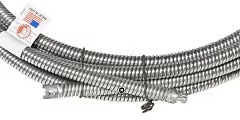Selecting the proper sewer cable size and type is very important -- a cable that is too small or too weak for the pipe or the obstruction will break or kink prematurely. A good drain cleaning cable must be used in the proper application, be flexible enough to execute bends in the pipe but be strong enough to develop sufficient torque to remove the drain clog.
Major types of sewer cables & drain snakes
- Inner Core
- No Core
- Double Wound
Inner core cable, is heavier than other sewer snakes without the added material and takes a bit longer for torque to develop.
A double wound drain cleaning cable, such as Spartan’s Magnum cable, is the strongest and lightest type of sewer cable on the market today. It is intended for use in runs with fewer bends or turns.
No core drain cables are used primarily on small residential pipes which can be difficult to navigate with heavier inner core cable.
The following chart is a guide to typical pipe sizes and the sizes of sewer drain cables that are most appropriate for cleaning applications:
| DRAIN SIZE | PIPE SIZE | RECOMMENDED CABLE SIZE |
|---|---|---|
| LAVATORY | 1 -- 1-1/4" | 1/4" |
| BATHTUB | 1-1/2" -- 2" | 1/4" OR 5/16" |
| SHOWERS | 2" -- 3" | 5/16", 3/8" OR 13/32" |
| FLOOR DRAIN | 3" OR MORE | 3/8", 13/32", 1/2", 5/8", 3/4" OR 0.55" |
| FLOOR DRAIN | 4" -- 5" | 1/2", 5/8", 3/4", 0.55" OR 0.66" |
| FLOOR DRAIN | 6" -- 8" | 5/8" (NON ROOTS), 3/4" OR 0.66" |
| FLOOR DRAIN | 8" OR MORE | 3/4" OR 0.66" |
Loading a Sewer Cable into Your Machine
Safe operation of any cable machine begins with proper cable handling and loading. Spartan drain cleaning cables arrive at the customer’s location as a wound coil.
Due to the amount of initial tension wound into your cable, care must be taken when uncoiling the bundle of cable. The cable will spring apart after the wire ties, which secure the cable, are cut.

After uncoiling the cable and laying out flat, attach the male end of the cable to the female end of the 10’ anchor in the drum. With the machine plugged in, depress the foot actuator and check the rotation of the drum. The drum should rotate in a counter-clockwise direction, as you face the front of the machine. If the drum rotates in the wrong direction, reverse the toggle switch located on the motor support and check rotation again. With the drum rotating in the proper direction, start feeding the cable into the drum.

Caution: Always wear riveted cable gloves when handling a rotating cable. Feed the cable into the drum with the drum rotating.
This insures proper distribution of cable inside the drum. Leave about 2-3 feet of cable out of the machine to allow for attaching the next section of cable. After loading your desired length of cable, attach either a two foot leader cable or a double male coupling. You are now ready to attach the cutter blade assembly.
Lastly, there are numerous “ends” that are often attached to the end of the drain snake. These “ends” serve various purposes from holding a cutting blade to retriever hooks. The choice is up to the professional sewer and drain cleaning technician, depending upon the situation at hand.
View our full list of sewer cable ends and their applications.
 US Dollars
US Dollars

